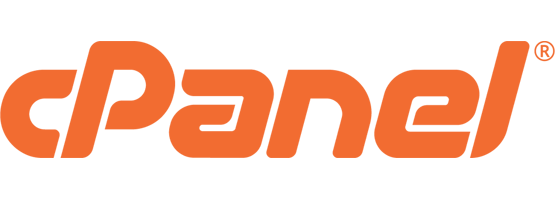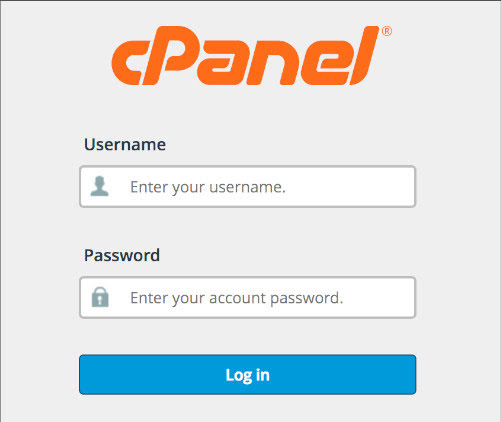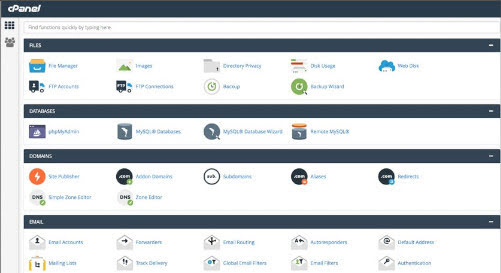
March 7th, 2019
When it comes to graphic interface, cPanel is number one on most people’s list. Most hosting firms use cPanel for their business. Why? It’s an easy to use web-based control panel for your VPS or dedicated server. cPanel gives you all the tools you need to manage and administer your own website, databases, and email in any browser.
Cpanel gives users a graphical interface from which they can control their portion of the Unix/Linux server. The tools provided are designed to simplify running and managing websites on your VPS or dedicated server. It uses a tiered structure that allows different levels of access. Administrators and end-users can control the various aspects of the server and the website directly through their browser. Depending on the hosting provider, cPanel will generally have some sort of auto installer or package dedicated to content management systems like WordPress.
CPanel is generally accessed using https on port 2083 or by adding “/cpanel” to the end of the hostname.


History of cPanel
cPanel, Inc. is a privately owned corporation headquartered in Houston, Texas. The software was initially designed as the control panel for Speed Hosting, a now-defunct web hosting company. The original author of cPanel, John Nick Koston, had a stake in Speed Hosting. Webking quickly began using cPanel after their merger with Speed Hosting. The new company moved its servers to Virtual Development Inc. (VDI), a now-defunct hosting facility. Following an agreement between Koston and VDI, cPanel was only available to customers hosted directly at VDI. At the time, there was little competition in the control panel market, with the main choices being VDI and Alabanza.
Eventually, due to Koston leaving for college, William Jensen and John Koston signed a Split Agreement. cPanel split into a separate program called WebPanel, and this version was run by VDI. Without the lead programmer, VDI was not able to continue any work on cPanel and eventually stopped supporting it altogether. Koston kept working on cPanel while also working at BurstNET. Finally, Nick left BurstNET on reasonable terms to focus entirely on cPanel. cPanel has since been updated and improved over the years.
cPanel 3 was released in 1999: main additions over cPanel 2 were an automatic upgrade and the Web Host Manager (WHM). The interface was also improved when Carlos Rego of Wizards Hosting made what became the default theme of cPanel. On August 20, 2018, cPanel announced it had signed an agreement to be acquired by a group led by Oakley Capital.
A version of cPanel for Microsoft Windows exists, titled Enkompass. As of October 15, 2011, Enkompass was offered free, as development for the product had been slowed. As of February 2014, Enkompass was declared end-of-life, with version 3 remaining available for download, but without further development or support.
Simplicity of cPanel
Not all people working with startups are versed on the technical tools used for VPS and dedicated server management. Server management of complex tasks is possible with just a few clicks. Regular backups, site and directory maintenance, checking up disk space, and other tasks can easily be performed. Administering your VPS or dedicated server requires Zero experience in server management.
The developers of cPanel have gone out of their way to make uploading and installing all types of files easy. cPanel is beneficial for those who are not good at learning how to work within a new interface. The Dashboard is user-friendly. There is a lot of documentation available for any type of operation in cPanel, especially with the latest version, which has built-in tutorials and walk-through information. In fact, there is a “how-to” page for just about everything.
With WordPress installed, a user can use cPanel to manage databases, domain names, mail accounts, and backups. cPanel makes it extremely easy for users to manage their websites on their VPS or dedicated server. Little or no technical knowledge of web hosting is needed.
Flexibility of cPanel
It’s just easier to manage a website via cPanel. No matter how complex a website might be, cPanel provides a VPS or dedicated server great features through which team members can manage your site. This includes maintaining an updated database, managing email accounts, and addresses, pooling multiple websites under one account, and monitoring site traffic, which helps you quickly troubleshoot and improve your website on the regular.
cPanel provides information you need to assess your web presence. Short for Advanced Web Statistics, AWStats is cPanel’s powerful log analyzer that will supply you with advanced web, FTP, mail, and streaming server statistics reports. This information will make your traffic analysis more precise and will enable you to take targeted steps to improve your site’s performance.
cPanel Extensions
Depending on the kind of VPS or dedicated server you run, your company might benefit in one or more of the various plug-ins you can use with cPanel. Some of the more popular plug-ins are:
| CSF Firewall | Clam AV Scanner | Munin Service Monitor |
| PHPselector | CMQ | RKHunter |
| WHM Interface | Spam D | Joomla |
| X-Cart | WHM Complete (WHMCS) | Dolphins |
Safe
cPanel is basically risk-free. The software itself stops VPS or dedicated server customers from doing anything risky or prohibited. It won’t allow you to cause any significant damage, no matter what you click within it.
Conclusion
VPS and dedicated server customers choose cPanel because of the benefits mentioned above. These may sound enough to convince a customer to use cPanel. However, it has even more benefits and advantages in detail. If you want to utilize a secure control panel system for your VPS or dedicated server for your Unix/Linux server, cPanel is the way to go.
If you would like to discuss this matter further, feel free to contact us.
